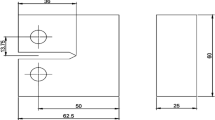Abstract
Four 7075-T651 aluminum alloys have been tested in tension in order to assess the applicability of the Schwalbe's model to the fracture toughness calculation. Standard K IC tests were performed on compact tension samples at room temperature, and the results compared with those from the Schwalbe's model which takes into account several mechanical properties derived from a conventional tensile test applied on round unnotched tensile samples, and the average dimple size of the corresponding fracture surfaces. The values of K IC calculated through the Schwalbe's model, correlate qualitatively well with those from the standard technique.
Fracture toughness deterioration is accompanied by a loss of the true fracture strain, strain hardening capacity and average dimple size. On the other hand, the higher the Zn/Mg ratio, the volume fraction of precipitates and the yield strength, the lower the fracture toughness. All these effects are originated in the presence of matrix precipitates. Therefore, the reduction in K IC can be explained in terms of the matrix response to the applied stress field as a function of the differences in volume fraction of the strengthening precipitates.
The round tension samples corresponding to the four materials, failed in a predominantly ductile transgranular fashion, which facilitates the application of the Schwalbe's model based in the characteristic dimples, developed in this mode of fracture, as a microstructural element size.
Similar content being viewed by others
References
Hahn, G.T. and Rosenfield, A.R.: Metallurgical factors affecting fracture toughness of aluminum alloys. Met. Trans., 6A:653-668, 1975.
Schulte, K.: The influence of incoherent particles on fatigue crack propagation under variable amplitude loading in high-strength aluminum alloys, K.L. Maurer & F.E. Matzer (eds.), London: Chameleon Press, p. 434, 1982.
Park, D.S., Kong, B.O., and Nam, S.W.: Effect of Mn-dispersoid on the low-cycle fatigue life of Al-Zn-Mg alloys. Met. Trans., 25A:1547-1550, 1994.
Bush, R.W., Bucci, R.J., Magnusen, P.E., and Kuhlman, G.W.: Fracture mechanics characteristics of high strength aluminum alloy forgings. Alcoa Laboratories Report, Q-395, Alcoa Techical Center, PA, August 1994.
Liu, Y.L., Zhang, Y., Hu, Z.Q., and Shi, C.X.: Grain structure, tensile properties and fracture behavior of an Al-Li-Cu-Mg-Zr alloy. Z Metallkd, 83:47-51, 1992.
Colvin, E.L., Petit, J.I., Westerlund, R.W., and Magnusen, P.E.: Damage tolerant aluminum alloy products useful for aircraft applications such as skin. U.S. Patent 5,213,639, 1993.
Staley, J.T. and Lege, D.J.: Advances in aluminum alloy products for structural applications in transportation. J. de Phys. IV 3:159-169, 1993.
Structural applications of mechanical alloying, F.H. Froes & J.J. deBarbadillo (eds.), ASM Int., Materials Park, OH, 1990.
Froes, F.H., Ward-Close, C.M., and Baeslack, W.: Advanced synthesis of lightweight metals. J. Adv. Mat., 20-29, Oct. 1993.
Froes, F.H.: Aerospace materials for the twenty-first century. Swis. Mat., 2:1-14, 1990.
Thompson, D.S.: Metallurgical factors affecting high strength aluminum alloy production. Met. Trans., 6A:671-683, 1975.
Ludtka, G.M. and Laughlin, D.E.: The effect of solute content on the slip behavior in 7XXX series aluminum alloys. Met. Trans., 12A:2083-2091, 1981.
Brockenbrough, J.R., Bucci, R.J., Hinkle, A.J., Magnusen, P.E., and Miyasato, S.M.: Role of microstructure on the fatigue durability of aluminum aircraft alloys. Office of Naval Research Contract No. N00014-91-C-0128, Dec. 29, 1993.
ASTM Standard Method E 399-81, Annual Book of ASTM Standards, Part 10, ASTM, Philadelphia, 1981.
Fracture toughness evaluation by R-curve methods, ASTM STP 527, ASTM 1973.
Standard test method for J IC, a measure of fracture toughness, ASTM Designation E 813-81, Annual Book of ASTM Standards, Vol. 03.01, 1983.
Slatcher, S. and Knott, J.F.: Advances in fracture mechanics, D. Francois (ed.), Pergamon Press, p. 201, 1971.
Ritchie, R.O., Server, W.L., and Wullaert, R.A.: Critical fracture stress and fracture strain models for the prediction of lower and upper shelf toughness in nuclear pressure vessels steels. Met. Trans., 10A:1557-1570, 1979.
Firrao, D. and Roberti, R.: Fracture, interactions of microstructure mechanisms and mechanics, J.M. Well & J.D. Landes (eds.), Warrendale, PA: TMS AIME, p. 165, 1984.
Barsom, J.M. and Pellegrino, J.V.: Relationship between K IC plane strain tensile ductility and microscopic mode of fracture. Eng. Fract. Mech., 5:209-221, 1973.
Hahn, G.T. and Rosenfield, A.R.: Application related phenomena in titanium alloys. ASTM STP 432, p. 5, 1968.
Schwalbe, K.H.: On the influence of microstructure on crack propagation mechanisms and fracture toughness of metallic materials. Eng. Fract. Mech., 9:795-832, 1977.
Van Stone, R.H. and Psioda, J.A.: Discussion of metallurgical factors affecting fracture toughness of aluminum alloys. Met. Trans., 6A:668-670, 1975.
Ludtka, G.M. and Laughlin, D.E.: The influence of microstructure and strength on the fracture mode and toughness of 7XXX series aluminum alloys. Met. Trans., 13A:411-425, 1982.
Chermant, J.L. and Coster, M.: Quantitative fractography. J. Mat. Sci. 14:509-534, 1979.
Hilders, O.A. and Santana, M.G.: Toughness and fractography of austenitic type 304 stainless steel with sensitization treatments at 973 K. Metallography, 21:151-164, 1988.
Hornbogen, E. and Gräf, M.: Fracture toughness of precipitation hardened alloys containing narrow soft zones at grain boundaries. Acta Met., 25:877-881, 1977.
Gräf, M. and Hornbogen, E.: Observation of ductile intercrystalline fracture of an Al-Zn-Mg alloy. Acta Met., 25:883-889, 1977.
Martin, J.W.: Micromechanisms in particle-hardened alloys R.W. Cahn, A.J. Forty, & I.M., Ward (eds.), Cambridge: Cambridge University Press, p. 125, 1980.
Hancock, J.W. and Thomson, R.D.: Strain and stress concentrations in ductile fracture by void nucleation growth and coalescence. Mat. Sci. and Tech., 1:684-690, 1985.
Little, E.A.: Fracture mechanics evaluations of neutron irradiated type 321 austenitic steel. J. Nucl. Mater., 139:261-276, 1986.
Author information
Authors and Affiliations
About this article
Cite this article
Hilders, O., Peña, N. On the Applicability of the Schwalbe's Model to the Fracture Toughness Calculation in 7075 Aluminum Alloys. Advanced Performance Materials 4, 49–61 (1997). https://doi.org/10.1023/A:1008620232065
Issue Date:
DOI: https://doi.org/10.1023/A:1008620232065




